Exploring the Block Model: Stewardship in Organizational Leadership
VerifiedAdded on 2023/01/16
|9
|2241
|68
Report
AI Summary
This report delves into the Block Model of Management, emphasizing the concept of stewardship and its application within organizations. It explores the model's principles, which advocate for employee empowerment, ethical considerations, and a focus on service over self-interest. The report highlights the potential benefits of implementing the Block Model, such as improved organizational performance, enhanced customer service, and the fostering of employee commitment and passion. It also acknowledges the challenges associated with its implementation, including inadequate understanding, resistance to change, and the potential for self-interest to undermine the model's principles. The report also discusses the importance of ethical considerations and awareness to ensure the Block Model's successful application. Through an analysis of these aspects, the report provides a comprehensive understanding of the Block Model's implications for leadership, management, and organizational success, particularly within the context of a gas cylinder delivery organization.
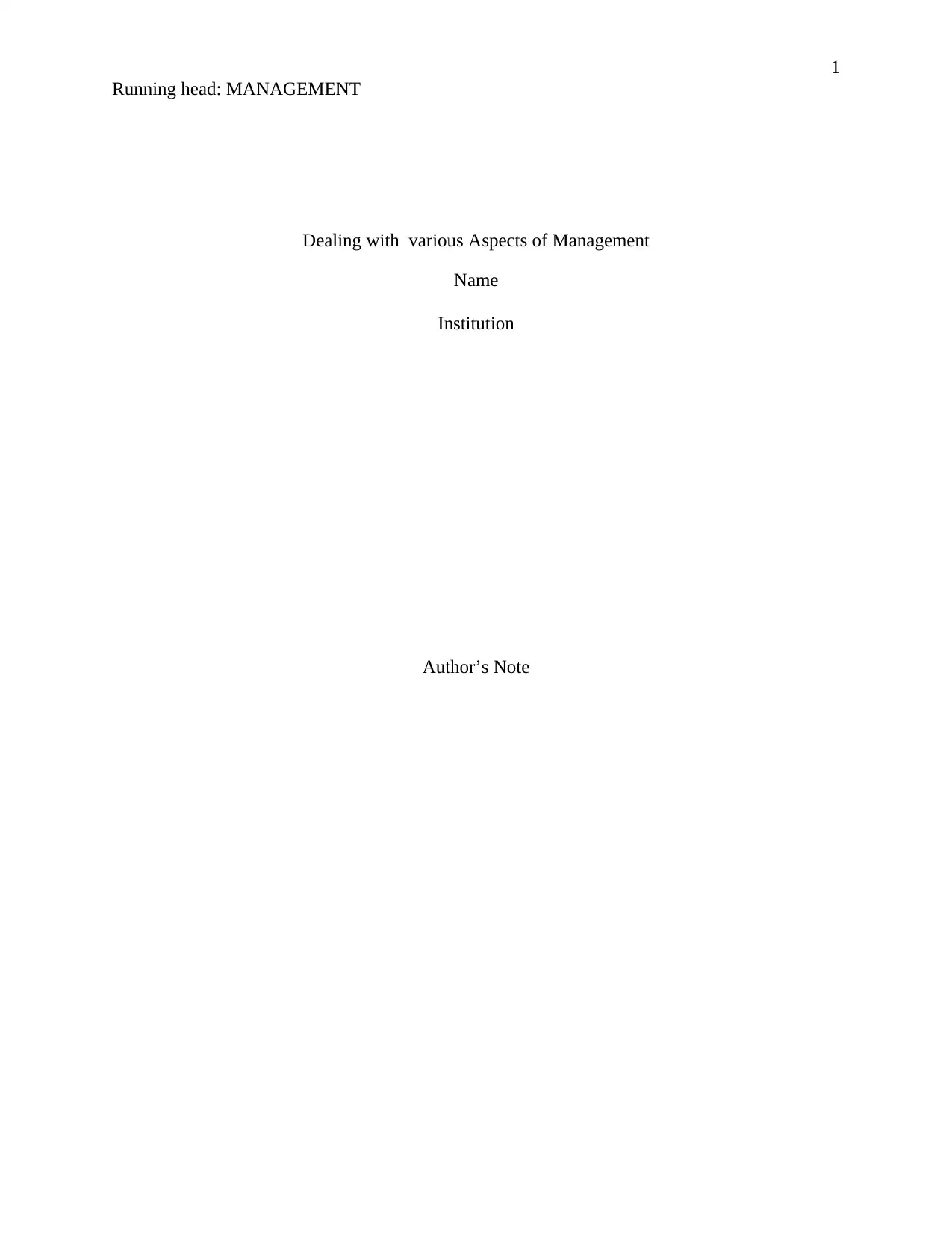
1
Running head: MANAGEMENT
Dealing with various Aspects of Management
Name
Institution
Author’s Note
Running head: MANAGEMENT
Dealing with various Aspects of Management
Name
Institution
Author’s Note
Paraphrase This Document
Need a fresh take? Get an instant paraphrase of this document with our AI Paraphraser
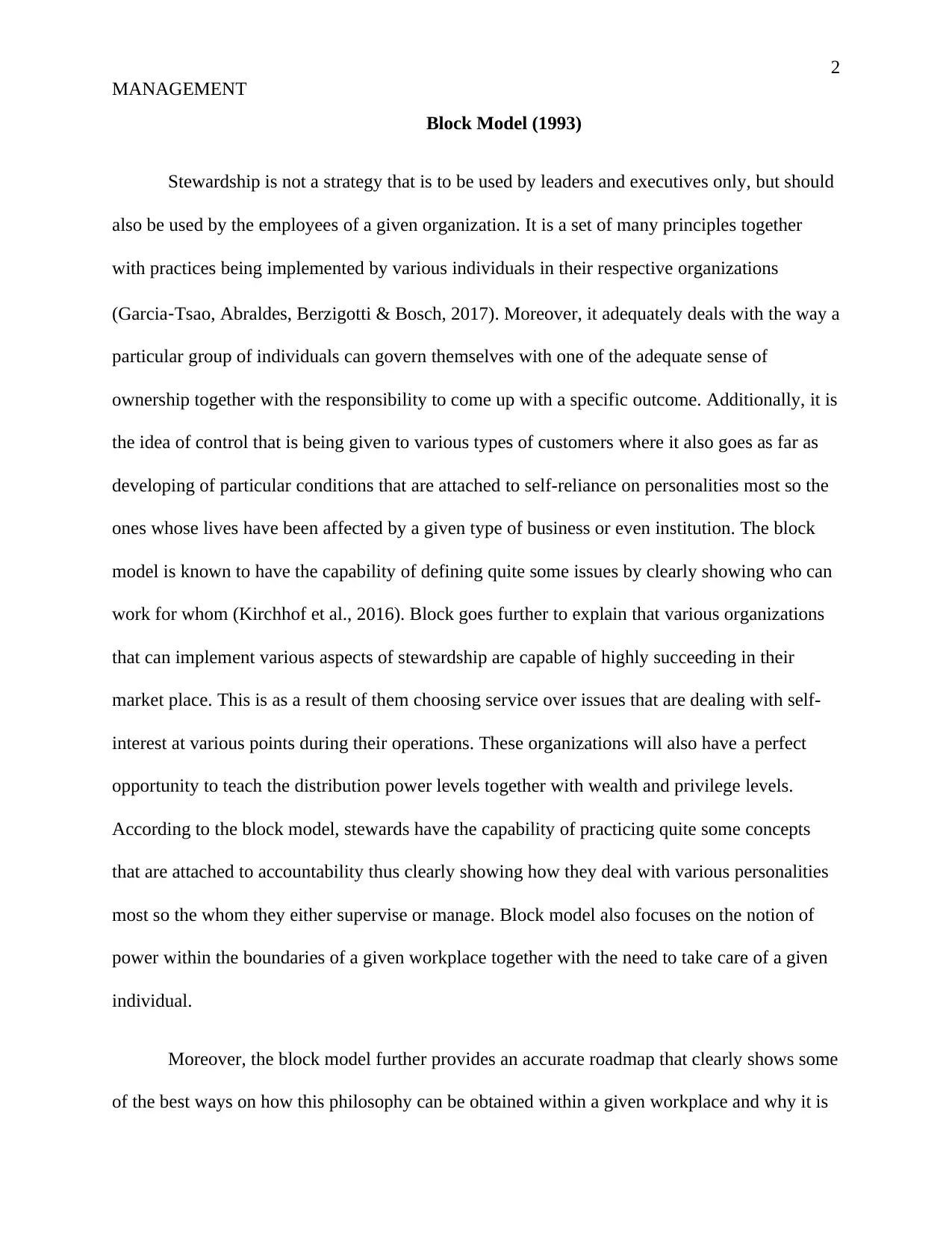
2
MANAGEMENT
Block Model (1993)
Stewardship is not a strategy that is to be used by leaders and executives only, but should
also be used by the employees of a given organization. It is a set of many principles together
with practices being implemented by various individuals in their respective organizations
(Garcia‐Tsao, Abraldes, Berzigotti & Bosch, 2017). Moreover, it adequately deals with the way a
particular group of individuals can govern themselves with one of the adequate sense of
ownership together with the responsibility to come up with a specific outcome. Additionally, it is
the idea of control that is being given to various types of customers where it also goes as far as
developing of particular conditions that are attached to self-reliance on personalities most so the
ones whose lives have been affected by a given type of business or even institution. The block
model is known to have the capability of defining quite some issues by clearly showing who can
work for whom (Kirchhof et al., 2016). Block goes further to explain that various organizations
that can implement various aspects of stewardship are capable of highly succeeding in their
market place. This is as a result of them choosing service over issues that are dealing with self-
interest at various points during their operations. These organizations will also have a perfect
opportunity to teach the distribution power levels together with wealth and privilege levels.
According to the block model, stewards have the capability of practicing quite some concepts
that are attached to accountability thus clearly showing how they deal with various personalities
most so the whom they either supervise or manage. Block model also focuses on the notion of
power within the boundaries of a given workplace together with the need to take care of a given
individual.
Moreover, the block model further provides an accurate roadmap that clearly shows some
of the best ways on how this philosophy can be obtained within a given workplace and why it is
MANAGEMENT
Block Model (1993)
Stewardship is not a strategy that is to be used by leaders and executives only, but should
also be used by the employees of a given organization. It is a set of many principles together
with practices being implemented by various individuals in their respective organizations
(Garcia‐Tsao, Abraldes, Berzigotti & Bosch, 2017). Moreover, it adequately deals with the way a
particular group of individuals can govern themselves with one of the adequate sense of
ownership together with the responsibility to come up with a specific outcome. Additionally, it is
the idea of control that is being given to various types of customers where it also goes as far as
developing of particular conditions that are attached to self-reliance on personalities most so the
ones whose lives have been affected by a given type of business or even institution. The block
model is known to have the capability of defining quite some issues by clearly showing who can
work for whom (Kirchhof et al., 2016). Block goes further to explain that various organizations
that can implement various aspects of stewardship are capable of highly succeeding in their
market place. This is as a result of them choosing service over issues that are dealing with self-
interest at various points during their operations. These organizations will also have a perfect
opportunity to teach the distribution power levels together with wealth and privilege levels.
According to the block model, stewards have the capability of practicing quite some concepts
that are attached to accountability thus clearly showing how they deal with various personalities
most so the whom they either supervise or manage. Block model also focuses on the notion of
power within the boundaries of a given workplace together with the need to take care of a given
individual.
Moreover, the block model further provides an accurate roadmap that clearly shows some
of the best ways on how this philosophy can be obtained within a given workplace and why it is
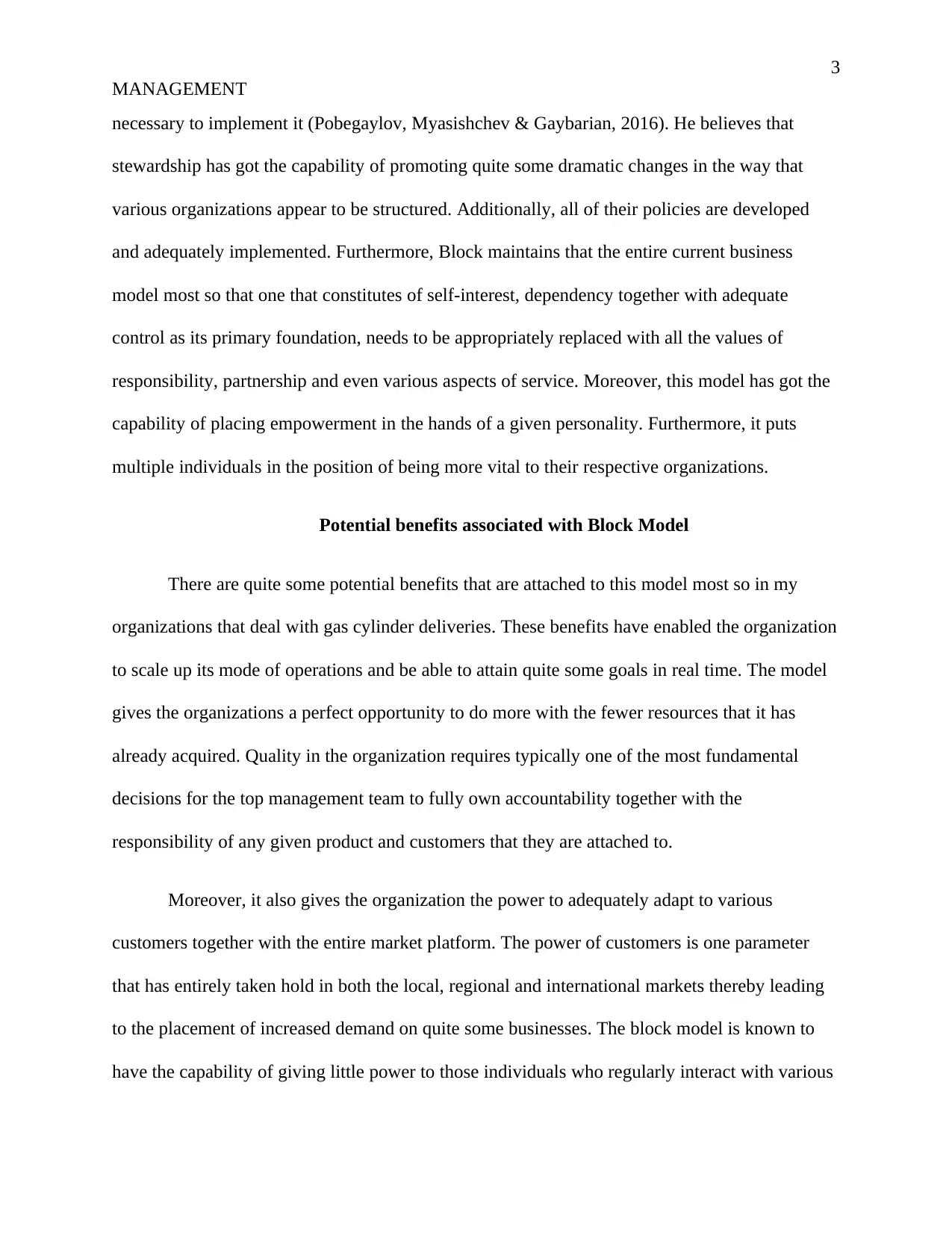
3
MANAGEMENT
necessary to implement it (Pobegaylov, Myasishchev & Gaybarian, 2016). He believes that
stewardship has got the capability of promoting quite some dramatic changes in the way that
various organizations appear to be structured. Additionally, all of their policies are developed
and adequately implemented. Furthermore, Block maintains that the entire current business
model most so that one that constitutes of self-interest, dependency together with adequate
control as its primary foundation, needs to be appropriately replaced with all the values of
responsibility, partnership and even various aspects of service. Moreover, this model has got the
capability of placing empowerment in the hands of a given personality. Furthermore, it puts
multiple individuals in the position of being more vital to their respective organizations.
Potential benefits associated with Block Model
There are quite some potential benefits that are attached to this model most so in my
organizations that deal with gas cylinder deliveries. These benefits have enabled the organization
to scale up its mode of operations and be able to attain quite some goals in real time. The model
gives the organizations a perfect opportunity to do more with the fewer resources that it has
already acquired. Quality in the organization requires typically one of the most fundamental
decisions for the top management team to fully own accountability together with the
responsibility of any given product and customers that they are attached to.
Moreover, it also gives the organization the power to adequately adapt to various
customers together with the entire market platform. The power of customers is one parameter
that has entirely taken hold in both the local, regional and international markets thereby leading
to the placement of increased demand on quite some businesses. The block model is known to
have the capability of giving little power to those individuals who regularly interact with various
MANAGEMENT
necessary to implement it (Pobegaylov, Myasishchev & Gaybarian, 2016). He believes that
stewardship has got the capability of promoting quite some dramatic changes in the way that
various organizations appear to be structured. Additionally, all of their policies are developed
and adequately implemented. Furthermore, Block maintains that the entire current business
model most so that one that constitutes of self-interest, dependency together with adequate
control as its primary foundation, needs to be appropriately replaced with all the values of
responsibility, partnership and even various aspects of service. Moreover, this model has got the
capability of placing empowerment in the hands of a given personality. Furthermore, it puts
multiple individuals in the position of being more vital to their respective organizations.
Potential benefits associated with Block Model
There are quite some potential benefits that are attached to this model most so in my
organizations that deal with gas cylinder deliveries. These benefits have enabled the organization
to scale up its mode of operations and be able to attain quite some goals in real time. The model
gives the organizations a perfect opportunity to do more with the fewer resources that it has
already acquired. Quality in the organization requires typically one of the most fundamental
decisions for the top management team to fully own accountability together with the
responsibility of any given product and customers that they are attached to.
Moreover, it also gives the organization the power to adequately adapt to various
customers together with the entire market platform. The power of customers is one parameter
that has entirely taken hold in both the local, regional and international markets thereby leading
to the placement of increased demand on quite some businesses. The block model is known to
have the capability of giving little power to those individuals who regularly interact with various
⊘ This is a preview!⊘
Do you want full access?
Subscribe today to unlock all pages.

Trusted by 1+ million students worldwide
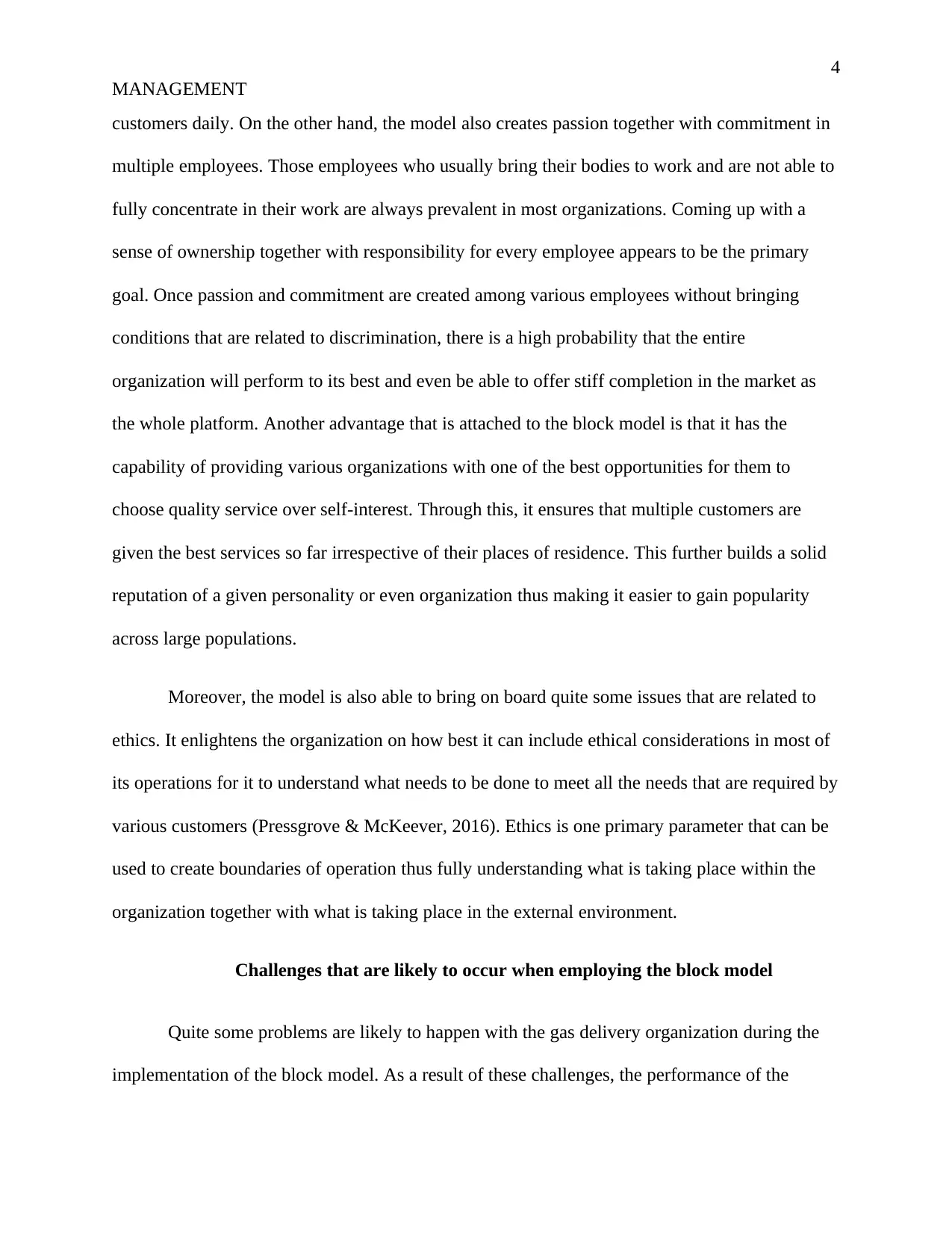
4
MANAGEMENT
customers daily. On the other hand, the model also creates passion together with commitment in
multiple employees. Those employees who usually bring their bodies to work and are not able to
fully concentrate in their work are always prevalent in most organizations. Coming up with a
sense of ownership together with responsibility for every employee appears to be the primary
goal. Once passion and commitment are created among various employees without bringing
conditions that are related to discrimination, there is a high probability that the entire
organization will perform to its best and even be able to offer stiff completion in the market as
the whole platform. Another advantage that is attached to the block model is that it has the
capability of providing various organizations with one of the best opportunities for them to
choose quality service over self-interest. Through this, it ensures that multiple customers are
given the best services so far irrespective of their places of residence. This further builds a solid
reputation of a given personality or even organization thus making it easier to gain popularity
across large populations.
Moreover, the model is also able to bring on board quite some issues that are related to
ethics. It enlightens the organization on how best it can include ethical considerations in most of
its operations for it to understand what needs to be done to meet all the needs that are required by
various customers (Pressgrove & McKeever, 2016). Ethics is one primary parameter that can be
used to create boundaries of operation thus fully understanding what is taking place within the
organization together with what is taking place in the external environment.
Challenges that are likely to occur when employing the block model
Quite some problems are likely to happen with the gas delivery organization during the
implementation of the block model. As a result of these challenges, the performance of the
MANAGEMENT
customers daily. On the other hand, the model also creates passion together with commitment in
multiple employees. Those employees who usually bring their bodies to work and are not able to
fully concentrate in their work are always prevalent in most organizations. Coming up with a
sense of ownership together with responsibility for every employee appears to be the primary
goal. Once passion and commitment are created among various employees without bringing
conditions that are related to discrimination, there is a high probability that the entire
organization will perform to its best and even be able to offer stiff completion in the market as
the whole platform. Another advantage that is attached to the block model is that it has the
capability of providing various organizations with one of the best opportunities for them to
choose quality service over self-interest. Through this, it ensures that multiple customers are
given the best services so far irrespective of their places of residence. This further builds a solid
reputation of a given personality or even organization thus making it easier to gain popularity
across large populations.
Moreover, the model is also able to bring on board quite some issues that are related to
ethics. It enlightens the organization on how best it can include ethical considerations in most of
its operations for it to understand what needs to be done to meet all the needs that are required by
various customers (Pressgrove & McKeever, 2016). Ethics is one primary parameter that can be
used to create boundaries of operation thus fully understanding what is taking place within the
organization together with what is taking place in the external environment.
Challenges that are likely to occur when employing the block model
Quite some problems are likely to happen with the gas delivery organization during the
implementation of the block model. As a result of these challenges, the performance of the
Paraphrase This Document
Need a fresh take? Get an instant paraphrase of this document with our AI Paraphraser
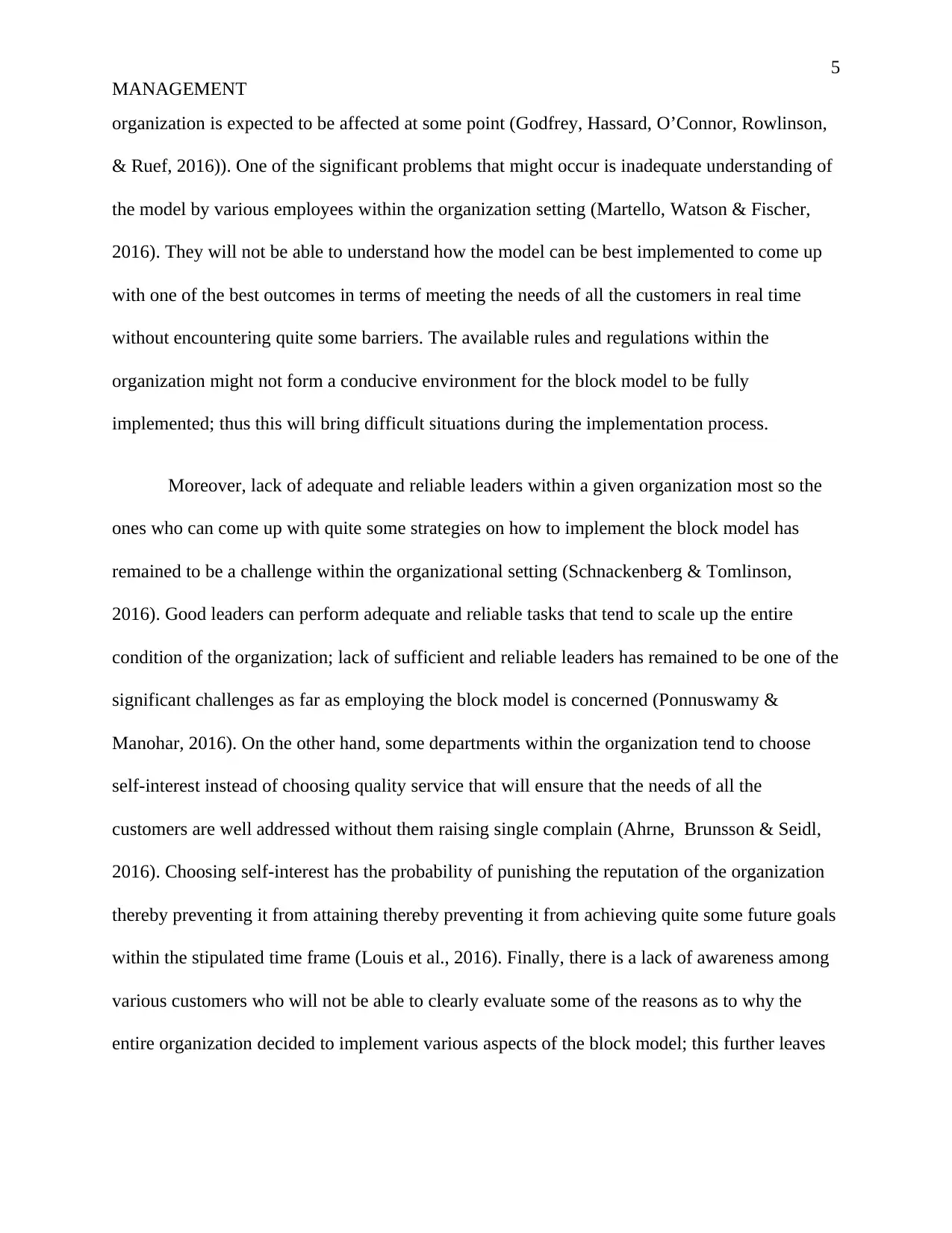
5
MANAGEMENT
organization is expected to be affected at some point (Godfrey, Hassard, O’Connor, Rowlinson,
& Ruef, 2016)). One of the significant problems that might occur is inadequate understanding of
the model by various employees within the organization setting (Martello, Watson & Fischer,
2016). They will not be able to understand how the model can be best implemented to come up
with one of the best outcomes in terms of meeting the needs of all the customers in real time
without encountering quite some barriers. The available rules and regulations within the
organization might not form a conducive environment for the block model to be fully
implemented; thus this will bring difficult situations during the implementation process.
Moreover, lack of adequate and reliable leaders within a given organization most so the
ones who can come up with quite some strategies on how to implement the block model has
remained to be a challenge within the organizational setting (Schnackenberg & Tomlinson,
2016). Good leaders can perform adequate and reliable tasks that tend to scale up the entire
condition of the organization; lack of sufficient and reliable leaders has remained to be one of the
significant challenges as far as employing the block model is concerned (Ponnuswamy &
Manohar, 2016). On the other hand, some departments within the organization tend to choose
self-interest instead of choosing quality service that will ensure that the needs of all the
customers are well addressed without them raising single complain (Ahrne, Brunsson & Seidl,
2016). Choosing self-interest has the probability of punishing the reputation of the organization
thereby preventing it from attaining thereby preventing it from achieving quite some future goals
within the stipulated time frame (Louis et al., 2016). Finally, there is a lack of awareness among
various customers who will not be able to clearly evaluate some of the reasons as to why the
entire organization decided to implement various aspects of the block model; this further leaves
MANAGEMENT
organization is expected to be affected at some point (Godfrey, Hassard, O’Connor, Rowlinson,
& Ruef, 2016)). One of the significant problems that might occur is inadequate understanding of
the model by various employees within the organization setting (Martello, Watson & Fischer,
2016). They will not be able to understand how the model can be best implemented to come up
with one of the best outcomes in terms of meeting the needs of all the customers in real time
without encountering quite some barriers. The available rules and regulations within the
organization might not form a conducive environment for the block model to be fully
implemented; thus this will bring difficult situations during the implementation process.
Moreover, lack of adequate and reliable leaders within a given organization most so the
ones who can come up with quite some strategies on how to implement the block model has
remained to be a challenge within the organizational setting (Schnackenberg & Tomlinson,
2016). Good leaders can perform adequate and reliable tasks that tend to scale up the entire
condition of the organization; lack of sufficient and reliable leaders has remained to be one of the
significant challenges as far as employing the block model is concerned (Ponnuswamy &
Manohar, 2016). On the other hand, some departments within the organization tend to choose
self-interest instead of choosing quality service that will ensure that the needs of all the
customers are well addressed without them raising single complain (Ahrne, Brunsson & Seidl,
2016). Choosing self-interest has the probability of punishing the reputation of the organization
thereby preventing it from attaining thereby preventing it from achieving quite some future goals
within the stipulated time frame (Louis et al., 2016). Finally, there is a lack of awareness among
various customers who will not be able to clearly evaluate some of the reasons as to why the
entire organization decided to implement various aspects of the block model; this further leaves
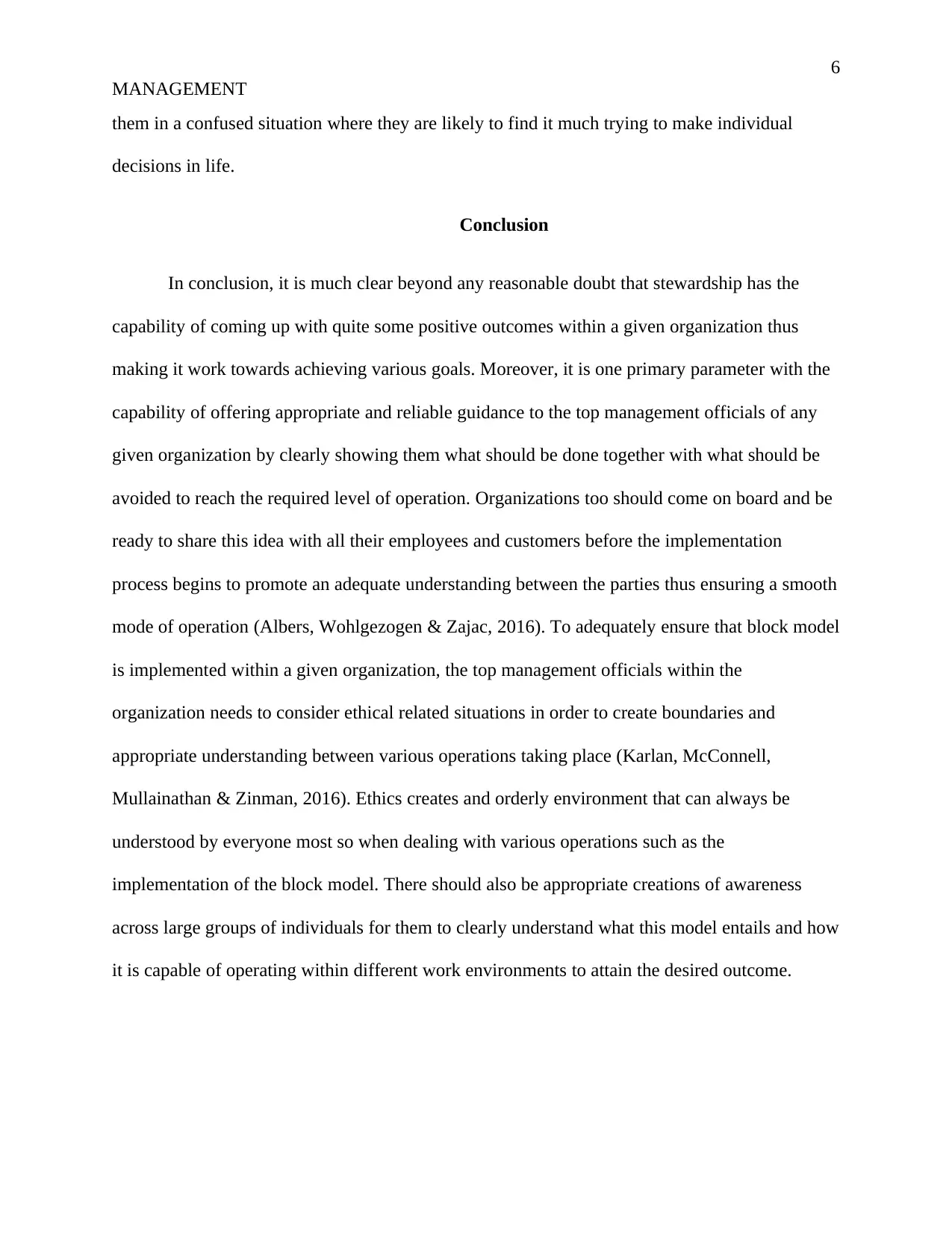
6
MANAGEMENT
them in a confused situation where they are likely to find it much trying to make individual
decisions in life.
Conclusion
In conclusion, it is much clear beyond any reasonable doubt that stewardship has the
capability of coming up with quite some positive outcomes within a given organization thus
making it work towards achieving various goals. Moreover, it is one primary parameter with the
capability of offering appropriate and reliable guidance to the top management officials of any
given organization by clearly showing them what should be done together with what should be
avoided to reach the required level of operation. Organizations too should come on board and be
ready to share this idea with all their employees and customers before the implementation
process begins to promote an adequate understanding between the parties thus ensuring a smooth
mode of operation (Albers, Wohlgezogen & Zajac, 2016). To adequately ensure that block model
is implemented within a given organization, the top management officials within the
organization needs to consider ethical related situations in order to create boundaries and
appropriate understanding between various operations taking place (Karlan, McConnell,
Mullainathan & Zinman, 2016). Ethics creates and orderly environment that can always be
understood by everyone most so when dealing with various operations such as the
implementation of the block model. There should also be appropriate creations of awareness
across large groups of individuals for them to clearly understand what this model entails and how
it is capable of operating within different work environments to attain the desired outcome.
MANAGEMENT
them in a confused situation where they are likely to find it much trying to make individual
decisions in life.
Conclusion
In conclusion, it is much clear beyond any reasonable doubt that stewardship has the
capability of coming up with quite some positive outcomes within a given organization thus
making it work towards achieving various goals. Moreover, it is one primary parameter with the
capability of offering appropriate and reliable guidance to the top management officials of any
given organization by clearly showing them what should be done together with what should be
avoided to reach the required level of operation. Organizations too should come on board and be
ready to share this idea with all their employees and customers before the implementation
process begins to promote an adequate understanding between the parties thus ensuring a smooth
mode of operation (Albers, Wohlgezogen & Zajac, 2016). To adequately ensure that block model
is implemented within a given organization, the top management officials within the
organization needs to consider ethical related situations in order to create boundaries and
appropriate understanding between various operations taking place (Karlan, McConnell,
Mullainathan & Zinman, 2016). Ethics creates and orderly environment that can always be
understood by everyone most so when dealing with various operations such as the
implementation of the block model. There should also be appropriate creations of awareness
across large groups of individuals for them to clearly understand what this model entails and how
it is capable of operating within different work environments to attain the desired outcome.
⊘ This is a preview!⊘
Do you want full access?
Subscribe today to unlock all pages.

Trusted by 1+ million students worldwide
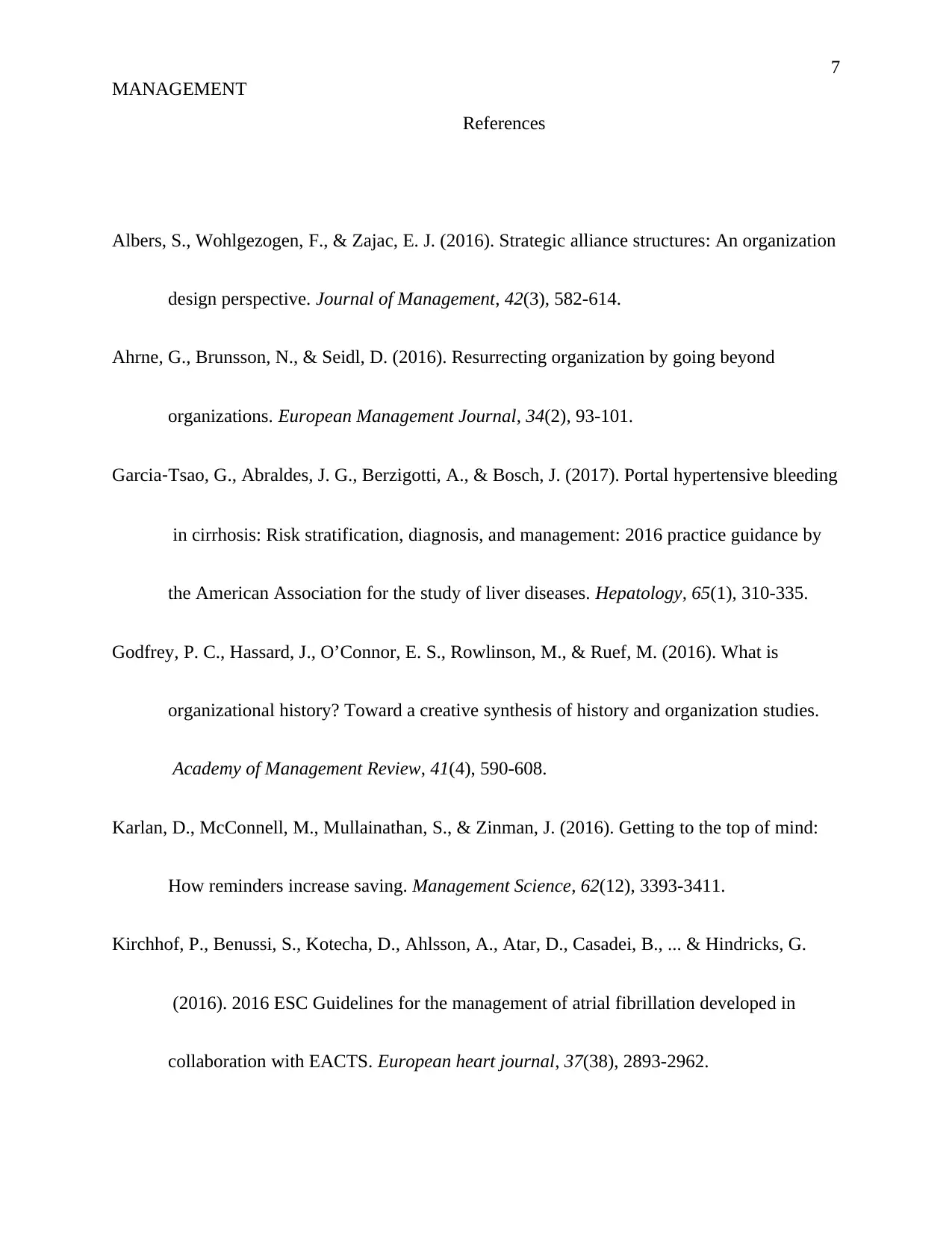
7
MANAGEMENT
References
Albers, S., Wohlgezogen, F., & Zajac, E. J. (2016). Strategic alliance structures: An organization
design perspective. Journal of Management, 42(3), 582-614.
Ahrne, G., Brunsson, N., & Seidl, D. (2016). Resurrecting organization by going beyond
organizations. European Management Journal, 34(2), 93-101.
Garcia‐Tsao, G., Abraldes, J. G., Berzigotti, A., & Bosch, J. (2017). Portal hypertensive bleeding
in cirrhosis: Risk stratification, diagnosis, and management: 2016 practice guidance by
the American Association for the study of liver diseases. Hepatology, 65(1), 310-335.
Godfrey, P. C., Hassard, J., O’Connor, E. S., Rowlinson, M., & Ruef, M. (2016). What is
organizational history? Toward a creative synthesis of history and organization studies.
Academy of Management Review, 41(4), 590-608.
Karlan, D., McConnell, M., Mullainathan, S., & Zinman, J. (2016). Getting to the top of mind:
How reminders increase saving. Management Science, 62(12), 3393-3411.
Kirchhof, P., Benussi, S., Kotecha, D., Ahlsson, A., Atar, D., Casadei, B., ... & Hindricks, G.
(2016). 2016 ESC Guidelines for the management of atrial fibrillation developed in
collaboration with EACTS. European heart journal, 37(38), 2893-2962.
MANAGEMENT
References
Albers, S., Wohlgezogen, F., & Zajac, E. J. (2016). Strategic alliance structures: An organization
design perspective. Journal of Management, 42(3), 582-614.
Ahrne, G., Brunsson, N., & Seidl, D. (2016). Resurrecting organization by going beyond
organizations. European Management Journal, 34(2), 93-101.
Garcia‐Tsao, G., Abraldes, J. G., Berzigotti, A., & Bosch, J. (2017). Portal hypertensive bleeding
in cirrhosis: Risk stratification, diagnosis, and management: 2016 practice guidance by
the American Association for the study of liver diseases. Hepatology, 65(1), 310-335.
Godfrey, P. C., Hassard, J., O’Connor, E. S., Rowlinson, M., & Ruef, M. (2016). What is
organizational history? Toward a creative synthesis of history and organization studies.
Academy of Management Review, 41(4), 590-608.
Karlan, D., McConnell, M., Mullainathan, S., & Zinman, J. (2016). Getting to the top of mind:
How reminders increase saving. Management Science, 62(12), 3393-3411.
Kirchhof, P., Benussi, S., Kotecha, D., Ahlsson, A., Atar, D., Casadei, B., ... & Hindricks, G.
(2016). 2016 ESC Guidelines for the management of atrial fibrillation developed in
collaboration with EACTS. European heart journal, 37(38), 2893-2962.
Paraphrase This Document
Need a fresh take? Get an instant paraphrase of this document with our AI Paraphraser
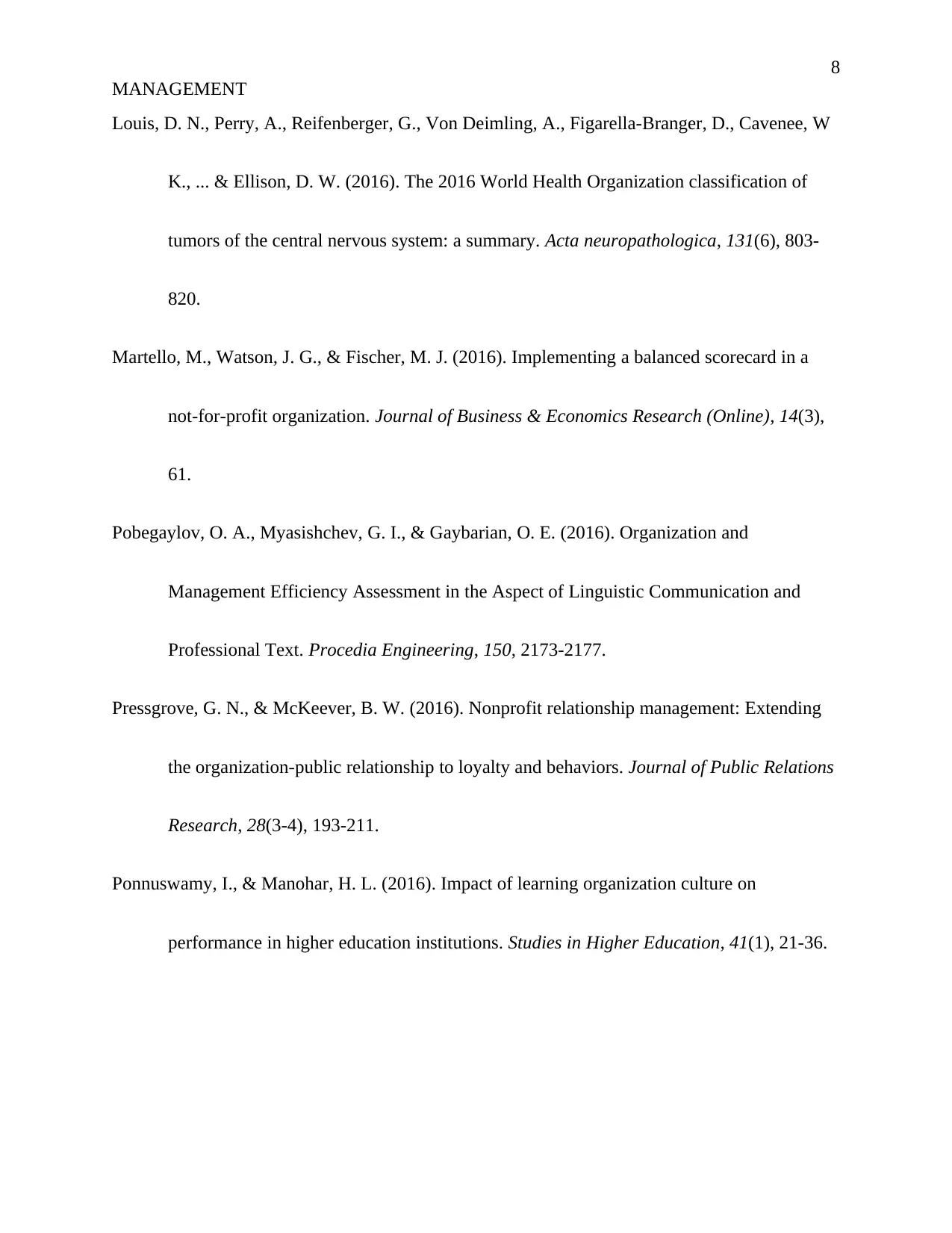
8
MANAGEMENT
Louis, D. N., Perry, A., Reifenberger, G., Von Deimling, A., Figarella-Branger, D., Cavenee, W
K., ... & Ellison, D. W. (2016). The 2016 World Health Organization classification of
tumors of the central nervous system: a summary. Acta neuropathologica, 131(6), 803-
820.
Martello, M., Watson, J. G., & Fischer, M. J. (2016). Implementing a balanced scorecard in a
not-for-profit organization. Journal of Business & Economics Research (Online), 14(3),
61.
Pobegaylov, O. A., Myasishchev, G. I., & Gaybarian, O. E. (2016). Organization and
Management Efficiency Assessment in the Aspect of Linguistic Communication and
Professional Text. Procedia Engineering, 150, 2173-2177.
Pressgrove, G. N., & McKeever, B. W. (2016). Nonprofit relationship management: Extending
the organization-public relationship to loyalty and behaviors. Journal of Public Relations
Research, 28(3-4), 193-211.
Ponnuswamy, I., & Manohar, H. L. (2016). Impact of learning organization culture on
performance in higher education institutions. Studies in Higher Education, 41(1), 21-36.
MANAGEMENT
Louis, D. N., Perry, A., Reifenberger, G., Von Deimling, A., Figarella-Branger, D., Cavenee, W
K., ... & Ellison, D. W. (2016). The 2016 World Health Organization classification of
tumors of the central nervous system: a summary. Acta neuropathologica, 131(6), 803-
820.
Martello, M., Watson, J. G., & Fischer, M. J. (2016). Implementing a balanced scorecard in a
not-for-profit organization. Journal of Business & Economics Research (Online), 14(3),
61.
Pobegaylov, O. A., Myasishchev, G. I., & Gaybarian, O. E. (2016). Organization and
Management Efficiency Assessment in the Aspect of Linguistic Communication and
Professional Text. Procedia Engineering, 150, 2173-2177.
Pressgrove, G. N., & McKeever, B. W. (2016). Nonprofit relationship management: Extending
the organization-public relationship to loyalty and behaviors. Journal of Public Relations
Research, 28(3-4), 193-211.
Ponnuswamy, I., & Manohar, H. L. (2016). Impact of learning organization culture on
performance in higher education institutions. Studies in Higher Education, 41(1), 21-36.
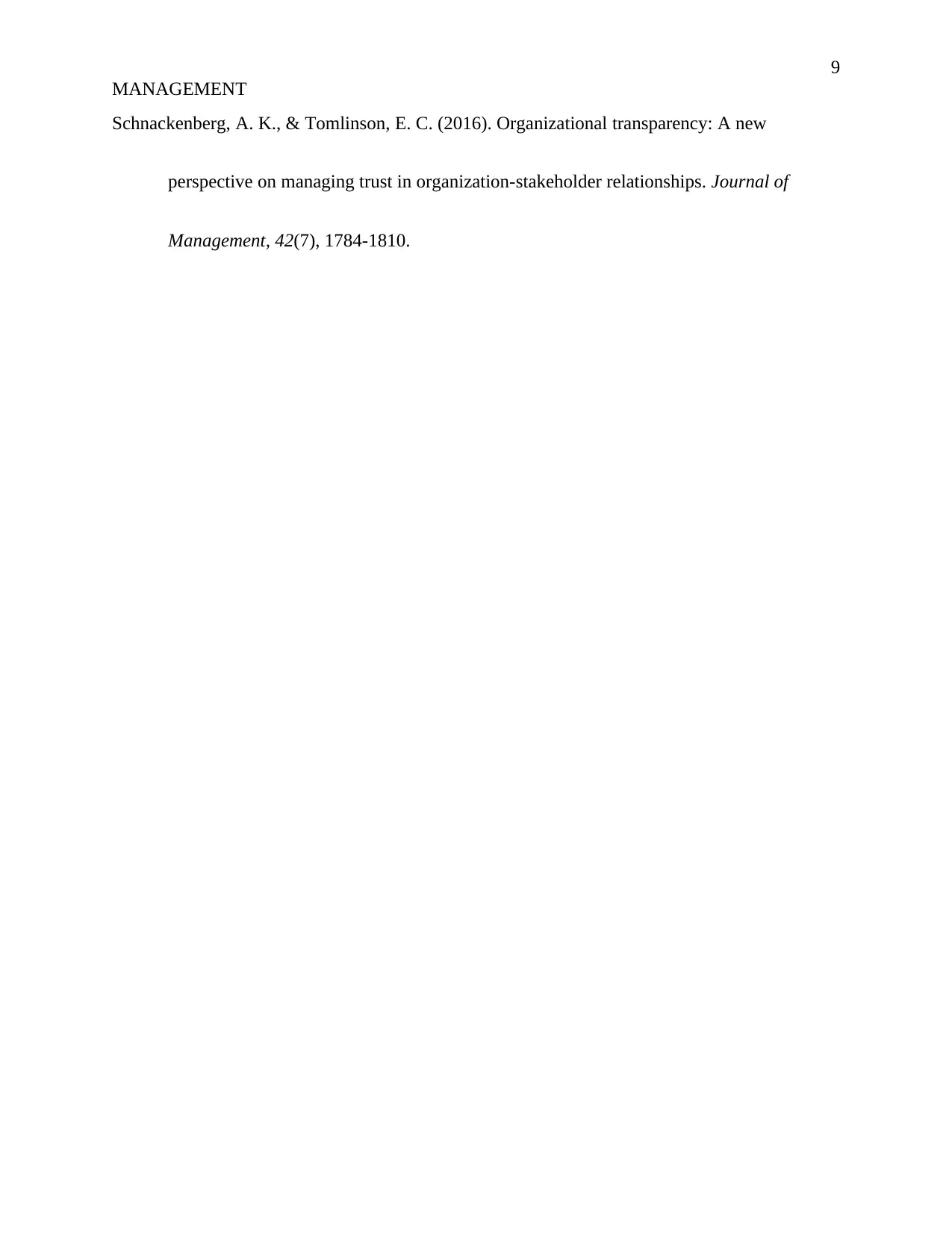
9
MANAGEMENT
Schnackenberg, A. K., & Tomlinson, E. C. (2016). Organizational transparency: A new
perspective on managing trust in organization-stakeholder relationships. Journal of
Management, 42(7), 1784-1810.
MANAGEMENT
Schnackenberg, A. K., & Tomlinson, E. C. (2016). Organizational transparency: A new
perspective on managing trust in organization-stakeholder relationships. Journal of
Management, 42(7), 1784-1810.
⊘ This is a preview!⊘
Do you want full access?
Subscribe today to unlock all pages.

Trusted by 1+ million students worldwide
1 out of 9
Related Documents
Your All-in-One AI-Powered Toolkit for Academic Success.
+13062052269
info@desklib.com
Available 24*7 on WhatsApp / Email
![[object Object]](/_next/static/media/star-bottom.7253800d.svg)
Unlock your academic potential
Copyright © 2020–2025 A2Z Services. All Rights Reserved. Developed and managed by ZUCOL.





